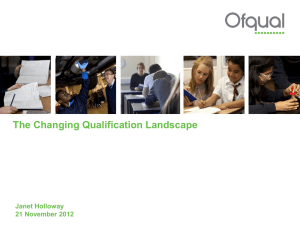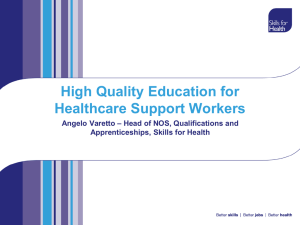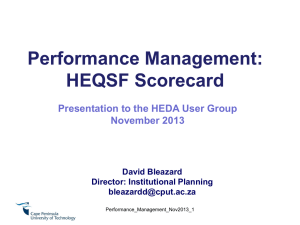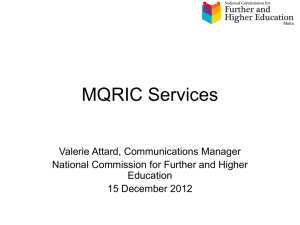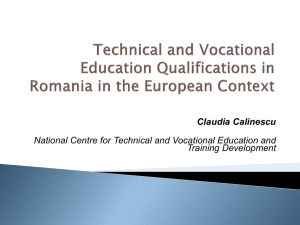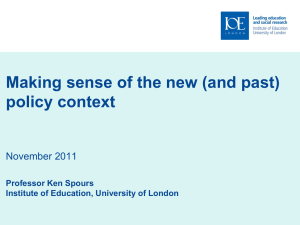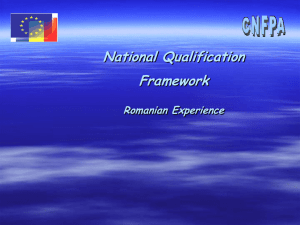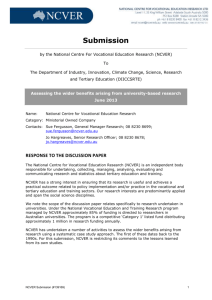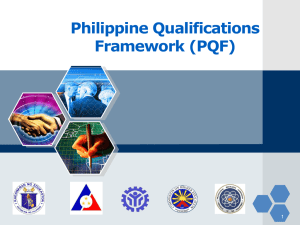International benchmarking of VET regulation
advertisement
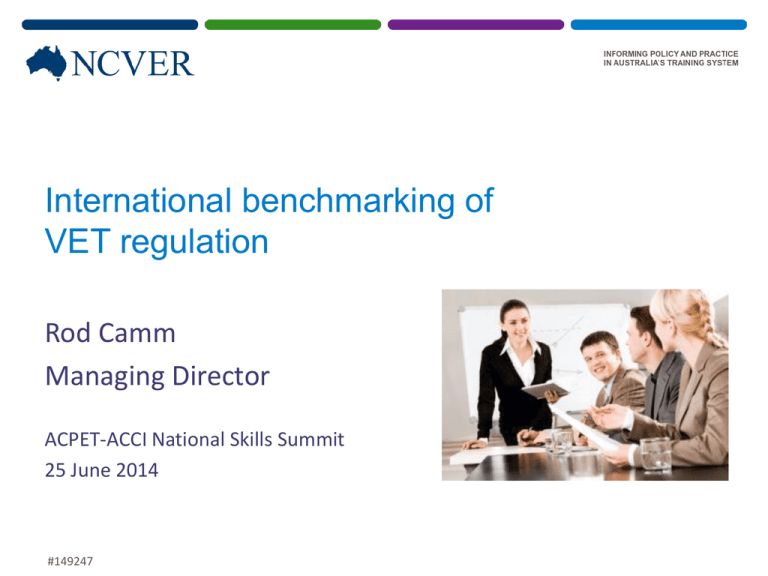
International benchmarking of VET regulation Rod Camm Managing Director ACPET-ACCI National Skills Summit 25 June 2014 #149247 What is quality? • Quality is a degree of excellence in products or services • Manufacturing: freedom from defects, consistency with pre-determined standards, meets customer needs • Health: safe, effective, person-centred, timely, efficient, equitable care • Education and training: effective teaching, learning and assessment, learner attainment of qualifications and skills that are valued in the labour market or for further education, learner satisfaction with training • Government funding agencies: ability of providers to meet accountability requirements Why we need quality Why we need quality • Variety of options for achieving qualifications has led to uncertainty about integrity of qualifications awarded • Reassure consumers of learning that qualifications and skills gained will be valued in labour market • Reassure employers of the value of a qualification • Give credit for qualifications gained in other systems • Increase transparency, portability and mutual recognition of qualifications across jurisdictional borders • Meet government accountability requirements Information from: • United Kingdom: England, Northern Ireland, Wales and Scotland • Finland, Germany, Sweden, Republic of Ireland • New Zealand, Singapore, South Korea • South Africa • Ontario, Canada, Accrediting agencies in USA Help employers and workers adjust to technology and market changes Skills framework Anticipate future skills needs (Build competencies for the future) Match training to needs of employers Maximise access to quality Vocational Education and Training Framework to link skills development to gains in productivity, employment and economic development Source: A Skilled Workforce for Strong, Sustainable and Balanced Growth: A G20 Training Strategy, International Labour Office, November 2010 Emerging themes • Education, skills and qualifications to improve local and national economic competitiveness • Internal quality assurance arrangements combined with external regulation • Standards for registration cover broadly similar areas • Stakeholders work with governments to develop relevant qualifications • Intensity of effort for gaining and retaining accreditation Emerging themes • Focus on objective measures of performance, including views of users and stakeholders • Improving transparency: publication of results of audits or inspections • User pays • Risk-based assessment to reduce regulatory burden Responsive regulation Responsive regulation Valerie Braithwaite (ANU, Migration compliance) • Start off with light touch, and use progressively stronger interventions • Strong interventions for unacceptable transgressions Malcolm Sparrow (Harvard, law enforcement and policing) • Look for root causes to identify possible courses of action • Skill is in identifying emerging issues and harms, study patterns and trends • Need to be constantly vigilant and apply swift action Responsive regulation Declan Roche (ANU, Australian Taxation) • Dual track approach – voluntary compliance combined with progressively more punitive approach • Use coercive enforcement only when non-coercive enforcement fails Arie Freiburg: (Monash University) • Need immediate action for unacceptable transgression Regulator suspends or cancels registration Regulator applies progressively stronger sanctions Regulator conducts formal investigations into breaches and complaints Regulator monitors activities via communications, site visits, agreed compliance actions Regulator educates and supports via good guidance material, advisory services, educational events, quality awards Source: Based on Australian Government, 2012: Australian Charities and Not for Profit Commission website , Taskforce Implementation Report , and concepts of responsive regulation from Valerie Braithwaite and Malcolm Sparrow Risk-based approaches Risk-based approaches • Practical solution to reducing regulatory burden • Concentrates resources where most needed • Needs sufficient information to calculate high and low risk ratings • Risk ratings applied to timing, frequency and nature of external reviews and inspections • A variety of triggers used to identify risk The quality of teaching and assessment European Union: Bruges Communiqué: • Need to invest in initial and continuing training of teachers, trainers, mentors and counsellors New Zealand Qualification Authority: • Standards for competent, appropriately experienced and qualified teachers, and effective assessment and moderation processes The quality of teaching and assessment Ofsted Inspections: • Evaluations of quality of teaching and assessment via observations and inspections Australia: • Discussion papers on need for improving quality of initial teacher training, continuing professional development, educational qualifications, registration of teachers and trainers, professional association Recent NCVER assessment research • Practitioners can identify key criteria for effective and quality assessments • Practical application is more challenging especially for ‘non-competent’ performance • No clear differentiation between validation and moderation practices • Rigorous up-front validation of assessment tools is believed to minimise the need for moderation Source: Misko, J, Halliday-Wynes S, Stanwick J, & Gemici S 2014, Quality Assessments: Practice and Perspectives, NCVER Recent NCVER assessment research • Low local involvement of employers in validating assessment instruments or assessment performance • Majority of providers prefer comprehensive evidence gathering for RPL assessments • There is little support for short duration courses Source: Misko, J, Halliday-Wynes S, Stanwick J, & Gemici S 2014, Quality Assessments: Practice and Perspectives, NCVER Self assessments Self assessments • Generally pre-cursor to external review • Labour intensive, need to include or provide access to data on participation and outcomes • External auditors or inspectors use data to undertake risk assessment, and criteria for audit • Provider describes how it has fared against criteria • Auditors or inspectors make on-site visits • Peer review processes used to support self-assessments (UK, Finland) • Publication of data may change how providers approach the exercise An increasing focus on outcomes • pass, retention, and graduation rates • learner progression rates • employment outcomes • completions of valued qualifications and or movement into higher qualifications • employer satisfaction rates • utilisation of skills in the workplace • participation rates for all learners including at risk and vulnerable groups continue to be used The cost of quality • Principle of user pays applies • Pre-accreditation workshops, provisional accreditation, initial accreditation, renewal of registration • Costs for auditor or auditing panel site visits (accommodation, per diem and travel) • Costs for variations in volume of qualifications, adding different locations • Costs for warnings, grievances and complaints • Comparable costs for registration for New Zealand and ASQA Key lessons • Quality arrangements align with cultural and economic environments • Political drivers and issues for regulatory coverage are broadly similar • Combination of self-monitoring, external audits or inspections, and objective evidence • All parts of the system must work in harmony Key lessons • Quality should be embedded into how we work every day • Risk-based triggers can focus audits where most needed • Protection of consumers is a critical objective • Users pay for quality services Questions?
